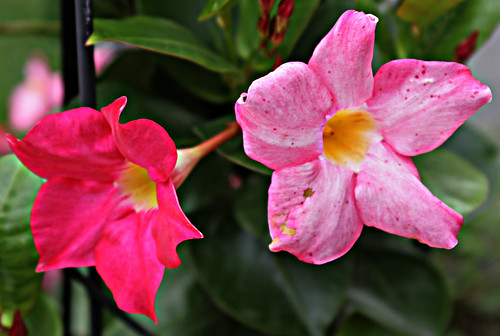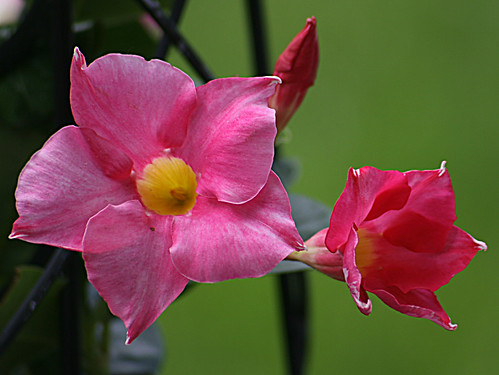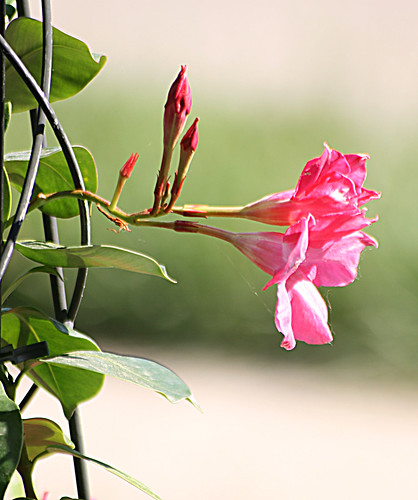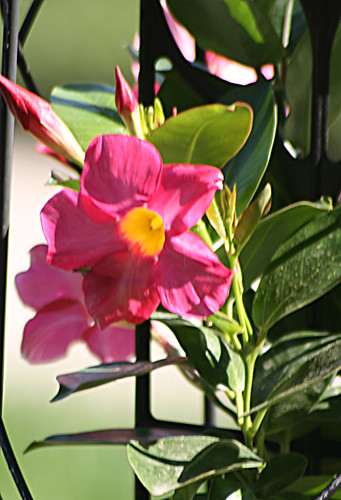Barbers' Garden 2008: Mandevilla
Image by bill barber
From my set entitled “Mandevilla”
www.flickr.com/photos/21861018@N00/sets/72157607213952426/
In my collection entitled “The Garden”
www.flickr.com/photos/21861018@N00/collections/7215760718...
From Wikipedia, the free encyclopedia
en.wikipedia.org/wiki/Mandevilla
Mandevilla, sometimes also called Dipladenia,[1] is a genus of plants. It consists of about 100 species, mostly tropical and subtropical flowering vines belonging to the family Apocynaceae, the Periwinkle family.
Mandevilla is native to Central and South America and many Mandevillas come originally from the Organ Mountains forests near Rio de Janeiro in Brazil. The genus was named after Henry Mandeville (1773-1861), a British diplomat and gardener.[1]
Mandevillas develop spectacular flowers in warm climates. The flowers come in a variety of colours, including white, pink, yellow, and red. As climbers, Mandevillas can be trained against a wall or trellis to provide a leafy green and often flowering picture of beauty. They have a tendency to attract insects like mealybugs and scales.
While Mandevilla scabra is sometimes as an additive to the psychedelic drink Ayahuasca, there is no evidence that it is psychoactive in its own right.[2] It is, however, considered to be toxic.[3]
The Barbers' Garden: Mandevilla
Image by bill barber
From my set entitled “Mandevilla”
www.flickr.com/photos/21861018@N00/sets/72157607213952426/
In my collection entitled “The Garden”
www.flickr.com/photos/21861018@N00/collections/7215760718...
From Wikipedia, the free encyclopedia
en.wikipedia.org/wiki/Mandevilla
Mandevilla, sometimes also called Dipladenia,[1] is a genus of plants. It consists of about 100 species, mostly tropical and subtropical flowering vines belonging to the family Apocynaceae, the Periwinkle family.
Mandevilla is native to Central and South America and many Mandevillas come originally from the Organ Mountains forests near Rio de Janeiro in Brazil. The genus was named after Henry Mandeville (1773-1861), a British diplomat and gardener.[1]
Mandevillas develop spectacular flowers in warm climates. The flowers come in a variety of colours, including white, pink, yellow, and red. As climbers, Mandevillas can be trained against a wall or trellis to provide a leafy green and often flowering picture of beauty. They have a tendency to attract insects like mealybugs and scales.
While Mandevilla scabra is sometimes as an additive to the psychedelic drink Ayahuasca, there is no evidence that it is psychoactive in its own right.[2] It is, however, considered to be toxic.[3]
The Barbers' Garden: Mandevilla
Image by bill barber
From my set entitled “Mandevilla”
www.flickr.com/photos/21861018@N00/sets/72157607213952426/
In my collection entitled “The Garden”
www.flickr.com/photos/21861018@N00/collections/7215760718...
From Wikipedia, the free encyclopedia
en.wikipedia.org/wiki/Mandevilla
Mandevilla, sometimes also called Dipladenia,[1] is a genus of plants. It consists of about 100 species, mostly tropical and subtropical flowering vines belonging to the family Apocynaceae, the Periwinkle family.
Mandevilla is native to Central and South America and many Mandevillas come originally from the Organ Mountains forests near Rio de Janeiro in Brazil. The genus was named after Henry Mandeville (1773-1861), a British diplomat and gardener.[1]
Mandevillas develop spectacular flowers in warm climates. The flowers come in a variety of colours, including white, pink, yellow, and red. As climbers, Mandevillas can be trained against a wall or trellis to provide a leafy green and often flowering picture of beauty. They have a tendency to attract insects like mealybugs and scales.
While Mandevilla scabra is sometimes as an additive to the psychedelic drink Ayahuasca, there is no evidence that it is psychoactive in its own right.[2] It is, however, considered to be toxic.[3]
The Barbers' Garden: Mandevilla
Image by bill barber
From my set entitled “Mandevilla”
www.flickr.com/photos/21861018@N00/sets/72157607213952426/
In my collection entitled “The Garden”
www.flickr.com/photos/21861018@N00/collections/7215760718...
From Wikipedia, the free encyclopedia
en.wikipedia.org/wiki/Mandevilla
Mandevilla, sometimes also called Dipladenia,[1] is a genus of plants. It consists of about 100 species, mostly tropical and subtropical flowering vines belonging to the family Apocynaceae, the Periwinkle family.
Mandevilla is native to Central and South America and many Mandevillas come originally from the Organ Mountains forests near Rio de Janeiro in Brazil. The genus was named after Henry Mandeville (1773-1861), a British diplomat and gardener.[1]
Mandevillas develop spectacular flowers in warm climates. The flowers come in a variety of colours, including white, pink, yellow, and red. As climbers, Mandevillas can be trained against a wall or trellis to provide a leafy green and often flowering picture of beauty. They have a tendency to attract insects like mealybugs and scales.
While Mandevilla scabra is sometimes as an additive to the psychedelic drink Ayahuasca, there is no evidence that it is psychoactive in its own right.[2] It is, however, considered to be toxic.[3]
Tidak ada komentar:
Posting Komentar